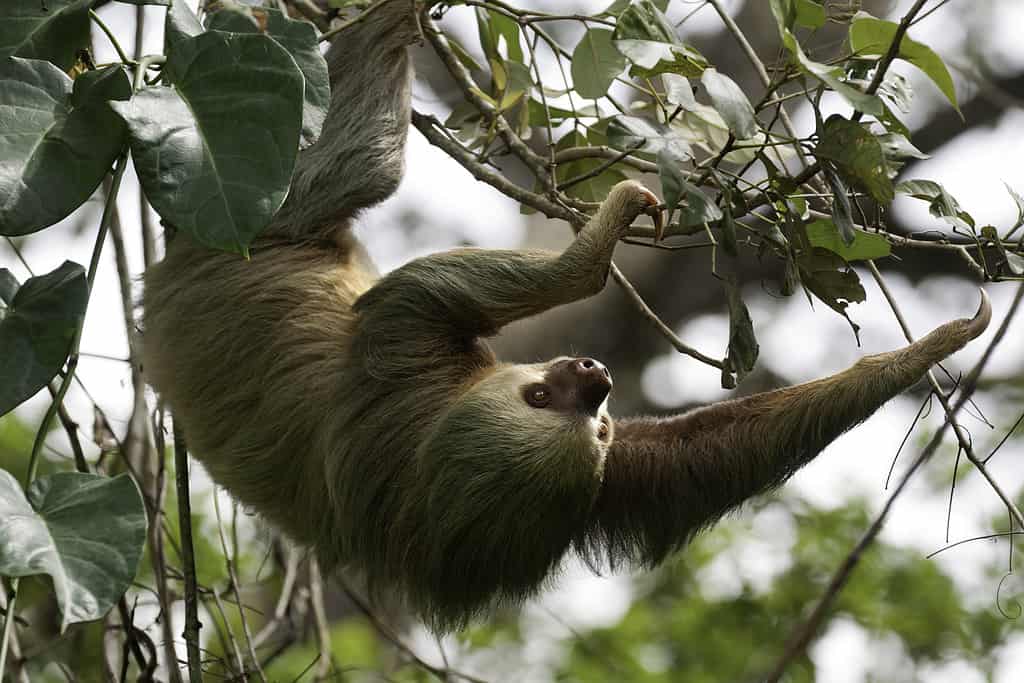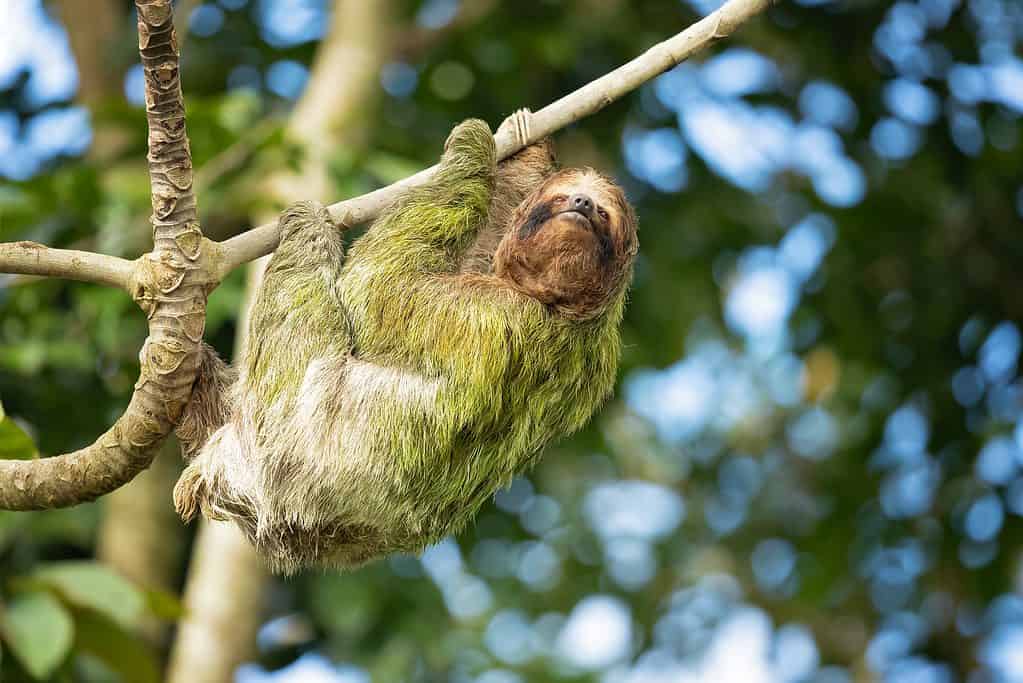Sloths have become an animal many people love. These slow-moving animals can do so much more than move at a pace that is painstakingly slow. Their digestive tracts are even super slow, so it can take as much as a month to digest one leaf. They can fall over 100 feet and survive to be super slow-paced another day. Sloths can even swim. They might not be up for the next Olympic medal, but they are surprisingly strong swimmers. Let’s check out some more interesting facts about sloths.
Overview of Sloths

Sloths have greenish fur due to the fungi, algae and moss that grows in it.
©nikpal/iStock via Getty Images
There are two types of sloths, two or three-toed. Altogether, there are six species of sloths in the world. The shaggy animal friends are native to Central and South America. They prefer canopy trees in the Amazon Rainforest and other rainforests.
Three-Toed Sloth Species
The physical characteristics of the three-toed sloth are similar to the two-toed cousins, though there are fairly obvious physical features that set the two apart. They have small heads with a dark mask across their eyes and a mouth that appears to always be smiling. The three-toes sloths have super long arms and an extra vertebrate in their necks, allowing them to turn their heads very far to check for danger.
Pygmy three-toed sloth (Bradypus pygmaeus) – These critically endangered sloths are only native to one area: Isla Escudo de Veraguas in Panama. They are roughly 40% slimmer than the other sloths and measure two feet long, and weigh 6.5 pounds.
Maned sloth (Bradypus torquatus) – These sloths only live on the Atlantic coast size of Brazil. They are light greyish brown with a dark mane of hair. They are the largest of the sloths and are currently vulnerable due to poaching and habitat loss.
Pale-throated sloth (Bradypus tridactylus) – These sloths live in northern South America from French Guiana to Suriname and Colombia. They have bright yellow faces and white throats.
Brown-throated sloth (Bradypus variegatus) – These sloths are native to northern South America, Panama, and Costa Rica in Central America. The brown-throated sloth is the most well-known.
Two-Toed Sloth Species
The two-toed species is larger than the three-toed species and weighs up to 24.5 pounds. They are longer than the three-toed sloths and measure up to 32 inches long. The two-toed sloths have larger, more pig-like snouts than their three-toed cousins. Similar to humans, two-toed sloths can have many different hair colors. They sweat when nervous, hot, or scared, just like humans!
Linnaeus’s two-toed sloth (Choloepus didactylus) – These sloths are similar in appearance to Hoffman’s two-toed sloth, except their facial, foot, and hand markings are darker. They live in rainforests in Venezuela, the Guyanas, and Colombia over to Ecuador, Peru, and Brazil north of the Amazon River. There may be a small population in Bolivia.
Hoffman’s two-toed sloth (Choloepus hoffmanni) – These sloths prefer an elevation of sea level up to 9,800 feet above sea level. They live in low to mid-level forests throughout eastern Honduras in Central America over to the Cloud Forests of western Ecuador in northern South America. In the southern half of South America, the sloths live in eastern Peru, western Brazil, and northern Bolivia.
The Fabulous Sloth’s Crazy Good Swimming Skills
Sloths might be slow-moving tree dwellers, but they also enjoy taking a dip in waterways. They swim three times faster than they walk, which may not seem like much, but seeing these shaggy animals swim is spectacular. Since they come equipped with an extra vertebrate in their necks, sloths have no trouble keeping their heads above water as they swim about.
More Interesting Sloth Facts

The brown-throated sloth (Bradypus variegatus) is a species of three-toed sloth found in the neotropical realm of Central and South America.
©Milan Zygmunt/Shutterstock.com
- Like the sloth in the photo above, many are covered in fungi, algae, moss, and living creatures, which can make the slow-moving sloths appear green. Their fur can contain a literal ecosystem of its own! In fact, scientists have discovered that sloths sometimes have specific types of fungi in the cracks of their fur that are used to treat antibiotic-resistant bacterial infections in humans. Each sloth can be the home for 1000 different insect species. Some insects, like the sloth moth, rely on the sloth to exist. The sloth-based ecosystem is studied for its potential breast cancer-curing fungi. It was able to slow the growth of cancer cells by 50%! This is just another way these adorable creatures amaze us.
- During the Cenozoic Era 65 million years ago, a giant ground sloth called a Megatherium existed. They stood over 12 feet tall and were approximately the same size as Asian elephants today. They also lived in America during the Pleistocene Epoch 2.6 million years ago before being hunted to extinction by humans.
- Sloths spend 90% of their time hanging upside down. It is not the same as when we hang upside down because a sloth’s organs are attached to their ribcage. Without organs pressing on their lungs like ours do, they are able to do perfectly fine from that extended position.
- Sloths have interesting bathroom habits. Their digestion is extremely slow, which slows down their ability to poop. Sloths poop once a week, but when they do, it makes up for lost time. They typically poop 1/3 their body weight when they do decide it’s time to go. Sloths are also extremely picky when it comes to choosing the right place. They will head down to the ground from high up in the tree’s canopy and then dig a hole to poop in. They never poop upside down.
- Sloths cannot fart. Their digestive systems are so slow that it is not possible. Instead, they breathe out the methane, giving them some stinky breath!
- The closest relatives that sloths have are the armadillo and anteater.
The photo featured at the top of this post is © jdross75/Shutterstock.com
Thank you for reading! Have some feedback for us? Contact the AZ Animals editorial team.







